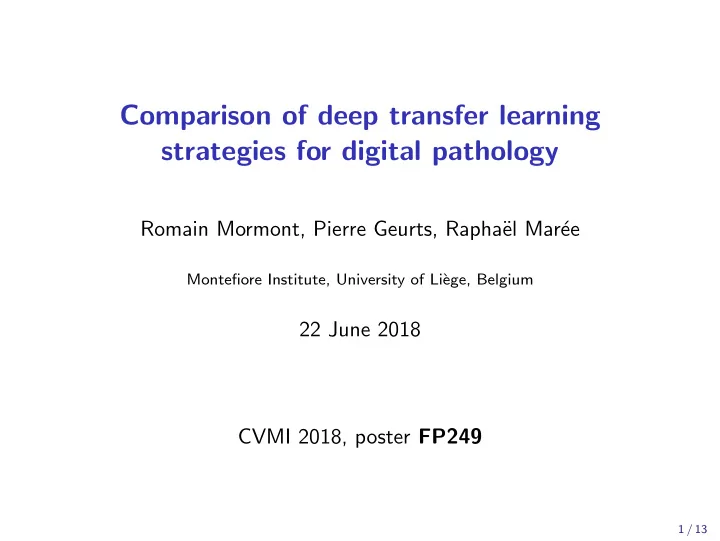

Comparison of deep transfer learning strategies for digital pathology Romain Mormont, Pierre Geurts, Rapha¨ el Mar´ ee Montefiore Institute, University of Li` ege, Belgium 22 June 2018 CVMI 2018, poster FP249 1 / 13
Digital pathology “ Digital pathology incorporates the acquisition, management, sharing and interpretation of pathology information — including slides and data — in a digital environment ” Digital slides: • big data: up to millions of biological objects per multi-gigapixel image • high variability: content, staining, acquisition,... • data scarcity: annotating data is expensive and tedious Need for efficient and versatile computer vision methods that can cope with data scarcity ! 2 / 13
Deep transfer learning Because of data scarcity, deep transfer learning is a promising approach for digital pathology. Deep transfer learning alleviates deep learning requirements: • requires less data • requires less computing resources and time 3 / 13
Using pre-trained networks There are mainly two ways of using pre-trained networks: 1. using pre-trained features off-the-shelf (OTS) 2. fine-tuning the networks 4 / 13
Deep transfer learning: how to ? Goal : devising guidelines and best practices for deep transfer learning in digital pathology: • Fine-tuning vs. OTS features: which one works better ? • Which network works better ? • Where to extract OTS features ? • ... 5 / 13
Deep transfer learning: how to ? We have carried out several experiments with ImageNet as source task: • OTS vs. fine-tuning • Networks: ResNet50, DenseNet201, VGG16/19, InceptionResNetV2,... • Features classifiers: SVM , extra-trees (ET),... • OTS features extraction at increasing depth • ... 6 / 13
Cytomine is an open-source web-based environment enabling collaborative multi-gigapixel image analysis ( uliege.cytomine.org ) Mar´ ee & al., Bioinformatics; 2016 7 / 13
Datasets 8 image classification datasets. Total Dataset Domain Cls Images Slides Necrosis (N) Histo 2 882 13 ProliferativePattern (P) Cyto 2 1857 36 CellInclusion (C) Cyto 2 3638 45 MouseLba (M) Cyto 8 4284 20 HumanLba (H) Cyto 9 5420 64 Lung (L) Histo 10 6331 882 Breast (B) Histo 2 23032 34 Glomeruli (G) Histo 2 29213 205 8 / 13
Results Fine-tuning is the best performing strategy Fine-tuning is often the best performing method ... but OTS features are close on most problems and less computationally expensive ! Datasets Strategy Cell Prolif Glom Necro Breast Mouse Lung Human Baseline (ET-FL) 0.9250 0.8268 0.9551 0.9805 0.9345 0.7568 0.8547 0.6960 Last layer 0.9822 0.8893 0.9938 0.9982 0.9603 0.7996 0.9133 0.7820 Feat. select. 0.9676 0.8861 0.9843 0.9994 0.9597 0.7438 0.8941 0.7703 Merg. networks 0.9897 0.8984 0.9948 0.9864 0.9549 0.8169 0.9155 0.7928 Merg. layers 0.9808 0.8906 0.9944 0.9964 0.9639 0.7941 0.9268 0.7977 Inner ResNet 0.9748 0.8959 0.9949 0.9964 0.9664 0.8131 0.9291 0.8113 Inner DenseNet 0.9862 0.8984 0.9962 0.9917 0.9699 0.8012 0.9268 0.7967 Inner IncResV2 0.9873 0.8948 0.9962 0.9982 0.9720 0.8137 0.9234 0.7713 Fine-tuning 0.9926 0.8797 0.9977 0.9970 0.9873 0.8727 0.9405 0.8641 Metric Roc AUC Accuracy (multi-class) Best in bold , second best in italic 9 / 13
Results When working with OTS features, use some inner layer features 10 / 13
Results More recent networks like DenseNet or ResNet work better See also: Kornblith, S., Shlens, J., & Le, Q. V. (2018). Do Better ImageNet Models Transfer Better? . arXiv preprint arXiv:1805.08974. 11 / 13
Conclusion Main takeaways: • Fine tuning is the best performing method • OTS features often close to fine-tuning and less computationally expensive • Prefer inner layers OTS features to last layers OTS features • Use more recent networks such as DenseNet and ResNet 12 / 13
Thank you ! Meet me at poster FP249 for more information ! 13 / 13
Recommend
More recommend